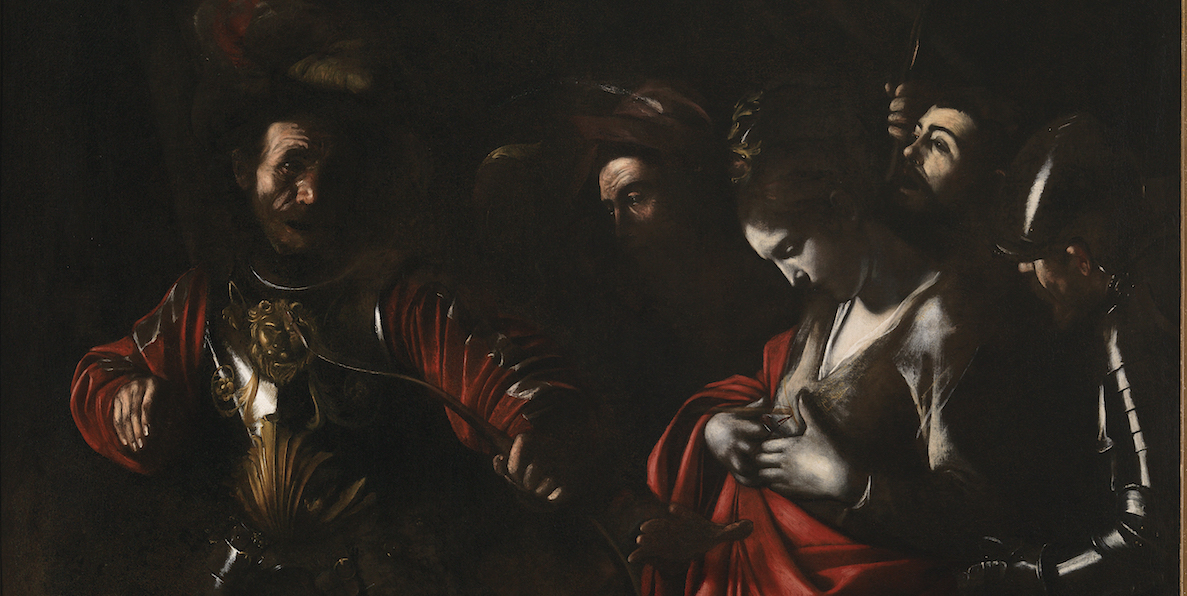Michelangelo Merisi da Caravaggio, as both a revolutionary artist and a violent individual in a violent age, divides eras and opinions.
His paintings are strikingly original and emotionally charged with their intense naturalism, dramatic lighting and powerful storytelling. These elements of his work have had a lasting impact on European art and continue to reverberate to this day. His focus on the human in depicting stories of the divine reversed the idealisation of the human primarily found in the Western tradition up to that point and introduced a new language to painting, one that would eventually result in Rembrandt’s ability to reveal the divine in his sitters and characters.
Caravaggio’s identification of the divine was in the grittiness and grime of the drama of human interaction, as befitted someone who lived life on the dramatic edge. His life story, from the point of making his reputation, is one of consistent argument, arrest and flight to the point of committing murder. His talent, though, regularly provided a means to potential rehabilitation before his violent tendencies eventually caught up with him and left him to die in penury.
The last Caravaggio here is ‘The Martyrdom of Saint Ursula’, 1610, displayed alongside another late work, ‘Salome receives the Head of John the Baptist’, from about 1609–10, together with an archival letter describing the last Caravaggio’s commission and two biographies documenting Caravaggio’s final days.

The picture was painted during the last months of his life, then despatched from Naples on 27 May before arriving in Genoa on 18 June 1610. Just weeks later, in July 1610, Caravaggio set out from Naples on a journey to return to Rome as he believed he was about to be pardoned for the murder committed in 1606, which had caused him to flee to the south. However, he unexpectedly died in Porto Ercole on 18 July 1610, never reaching his destination.
In the tightly cropped composition of ‘The Martyrdom of Saint Ursula’ Caravaggio depicts the moment of the saint’s death; the moment in which Ursula, having refused to marry a Hun who did not share her Christian faith, is shot by him with an arrow. Chiaroscuro, a complex interplay of light and shadow, is a characteristic of many paintings by Caravaggio, giving scenes such as this tremendous dramatic emphasis. Another characteristic feature is a focus on the hands of his characters. Here, the viewer is faced with an intricate depiction of hands: the guilty hands that have just fired the arrow, Ursula’s hands framing the fatal wound in her chest, and the bystander’s hand thrust between the two protagonists just moments too late.
‘The Martyrdom of Saint Ursula’ is the last Caravaggio in the sense that it is the last fully documented work of his that we have today. As such, it also contains the last self-portrait of Caravaggio, as he was in the habit of including himself as a character within many of the scenes he portrayed. This self-representation may contain hints of Caravaggio’s own state of mind during what were to be his final days and months. However, it seems unlikely that he had any premonition of advancing death, as he planned to return to Rome in anticipation of a forthcoming pardon.
The last Caravaggio was also, for many years, a lost Caravaggio as the painting came to be misattributed to a follower of his and was only definitely re-attributed in 1980 following the discovery of letters relating to its commission. Although it is probably the last known Caravaggio we have today, there may be more lost last Caravaggios out there. Three paintings were also included when he loaded his possessions onto a boat to begin his return to Rome. Partway through this journey, he was arrested during a port call and, after having bought his way out of jail, he found the boat had sailed without him taking his possessions, including those paintings with it. They were never recovered by him, as his journey on land to try to catch up with the boat resulted in his contracting the illness from which he died.
So, while another of those works may literally have been the last Caravaggio, the display of both these works together reveals much about his late style. He favours the close-up and tight crop, depicting key characters and exploring the psychology of their actions and responses. Having suffered repeatedly from the consequences of his own hot-headed and violent temperament, both paintings are studies in the immediate consequences of violent acts. Salome cannot face the head of John the Baptist, whose decapitation she has ordered, while the King of the Huns, who has killed Ursula with his arrow, seems caught between anger and regret.
The spaces they inhabit are dark as their deeds, while also being dramatically lit from one source to spotlight their tortured emotions and torturing actions. The artist who was seemingly unable to control his own violent urges was, in later times of reflection, able, compellingly, to reveal not just the horror of such violence but also of the conflicting emotions that trigger and then follow such outbursts. The internal drama that he depicts and on which he focuses our attention is as compelling, if not more so, than the gruesome actions themselves. As warnings about the personal and societal consequences of violence, these paintings serve as the confessions of one for whom such actions destroyed his reputation and shortened his life, depriving us of much more from his undoubted genius.
It is this, more than a sense of the final statement, that derives from the element of self-revelation and portrait to be found in these late works. They deserve analysis in terms of what they show us of mimetic desire and the mechanism of scapegoating as Caravaggio depicts in his characters the realisation he had, no doubt, reached personally: that instinctive violence ruins the lives of both perpetrator and victim.
‘The Last Caravaggio’, Room 46, National Gallery, 18 April – 21 July 2024
Visit Here

